warning light DODGE DURANGO 2004 2.G Owner's Manual
[x] Cancel search | Manufacturer: DODGE, Model Year: 2004, Model line: DURANGO, Model: DODGE DURANGO 2004 2.GPages: 386, PDF Size: 6.22 MB
Page 217 of 386

PARKING BRAKE
The foot operated parking brake is positioned below the
lower left corner of the instrument panel. To release the
parking brake, pull the parking brake release handle.Be sure the parking brake is firmly set when parked and
the gear-shift lever is in PARK position. When parking on
a hill you should apply the Parking Brake before placing
the gear shift lever in PARK; otherwise the load on the
transmission locking mechanism may make it difficult to
move the selector out of PARK.
NOTE:The instrument cluster brake warning light
indicates only that the parking brake is applied. You must
be sure the parking brake is fully applied before leaving
the vehicle.
When parking on a hill, turn the front wheels toward the
curb on a downhill grade and away from the curb on an
uphill grade.
The parking brake should be applied whenever the
driver is not in the vehicle.
STARTING AND OPERATING 217
5
Page 219 of 386
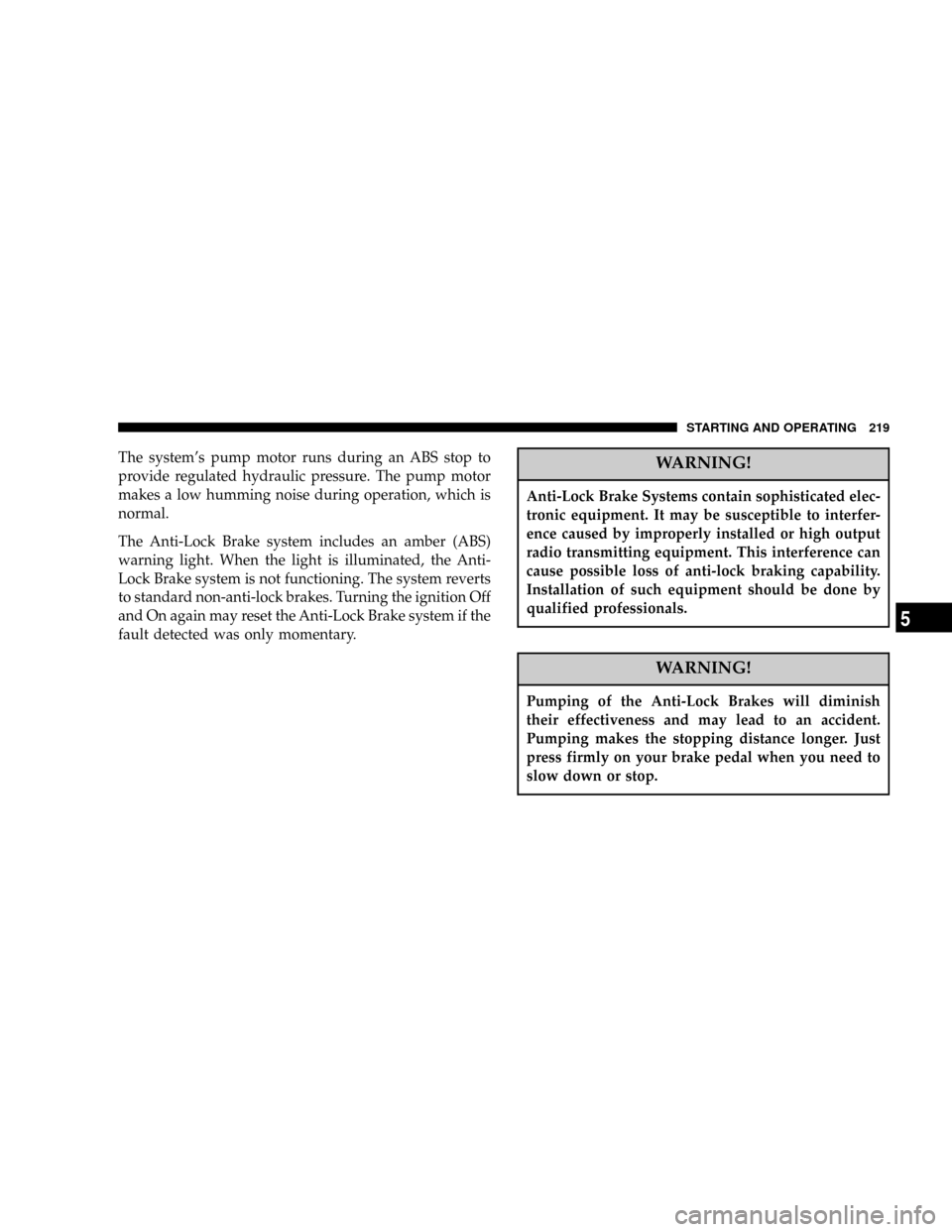
The system's pump motor runs during an ABS stop to
provide regulated hydraulic pressure. The pump motor
makes a low humming noise during operation, which is
normal.
The Anti-Lock Brake system includes an amber (ABS)
warning light. When the light is illuminated, the Anti-
Lock Brake system is not functioning. The system reverts
to standard non-anti-lock brakes. Turning the ignition Off
and On again may reset the Anti-Lock Brake system if the
fault detected was only momentary.WARNING!
Anti-Lock Brake Systems contain sophisticated elec-
tronic equipment. It may be susceptible to interfer-
ence caused by improperly installed or high output
radio transmitting equipment. This interference can
cause possible loss of anti-lock braking capability.
Installation of such equipment should be done by
qualified professionals.
WARNING!
Pumping of the Anti-Lock Brakes will diminish
their effectiveness and may lead to an accident.
Pumping makes the stopping distance longer. Just
press firmly on your brake pedal when you need to
slow down or stop.
STARTING AND OPERATING 219
5
Page 247 of 386
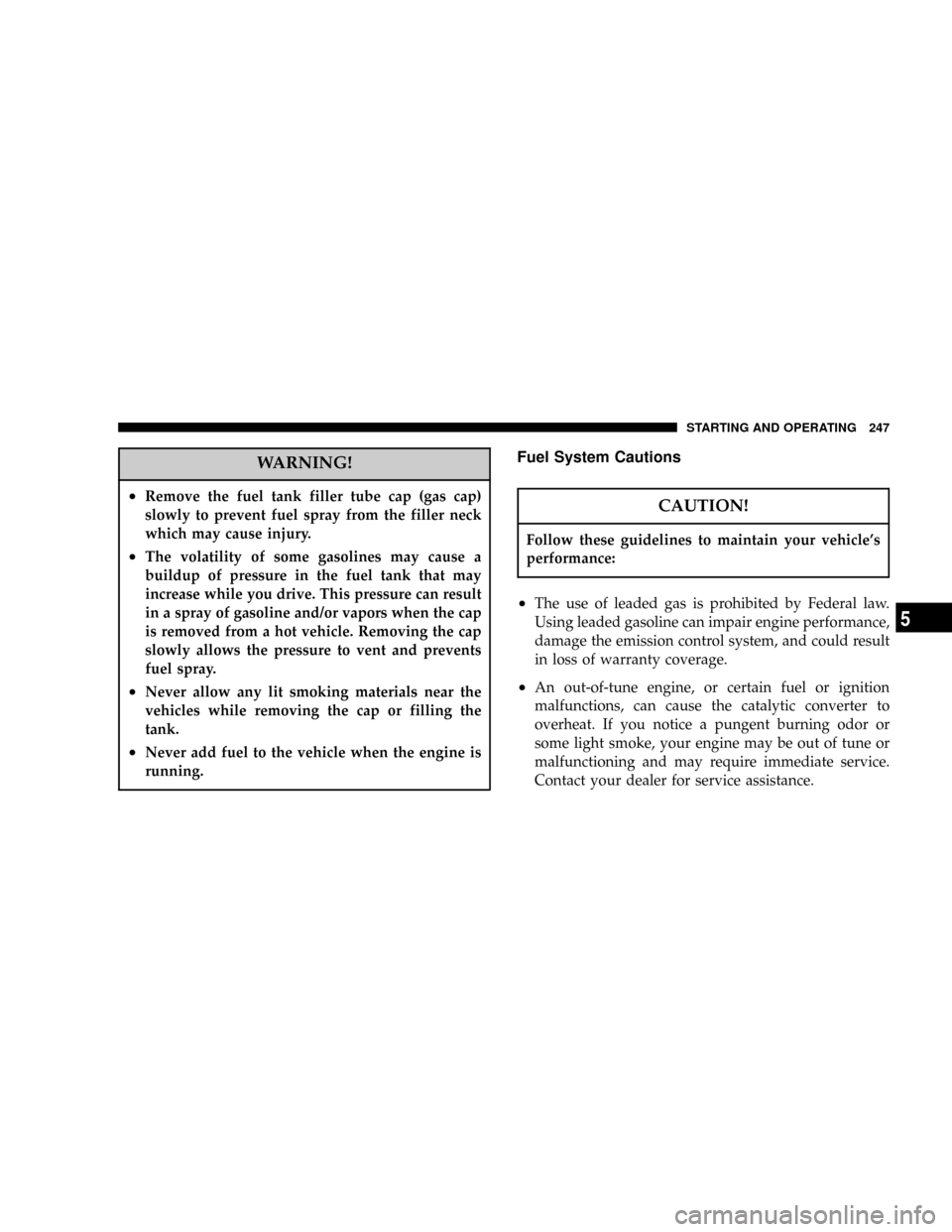
WARNING!
²Remove the fuel tank filler tube cap (gas cap)
slowly to prevent fuel spray from the filler neck
which may cause injury.
²The volatility of some gasolines may cause a
buildup of pressure in the fuel tank that may
increase while you drive. This pressure can result
in a spray of gasoline and/or vapors when the cap
is removed from a hot vehicle. Removing the cap
slowly allows the pressure to vent and prevents
fuel spray.
²Never allow any lit smoking materials near the
vehicles while removing the cap or filling the
tank.
²Never add fuel to the vehicle when the engine is
running.
Fuel System Cautions
CAUTION!
Follow these guidelines to maintain your vehicle's
performance:
²The use of leaded gas is prohibited by Federal law.
Using leaded gasoline can impair engine performance,
damage the emission control system, and could result
in loss of warranty coverage.
²An out-of-tune engine, or certain fuel or ignition
malfunctions, can cause the catalytic converter to
overheat. If you notice a pungent burning odor or
some light smoke, your engine may be out of tune or
malfunctioning and may require immediate service.
Contact your dealer for service assistance.
STARTING AND OPERATING 247
5
Page 248 of 386
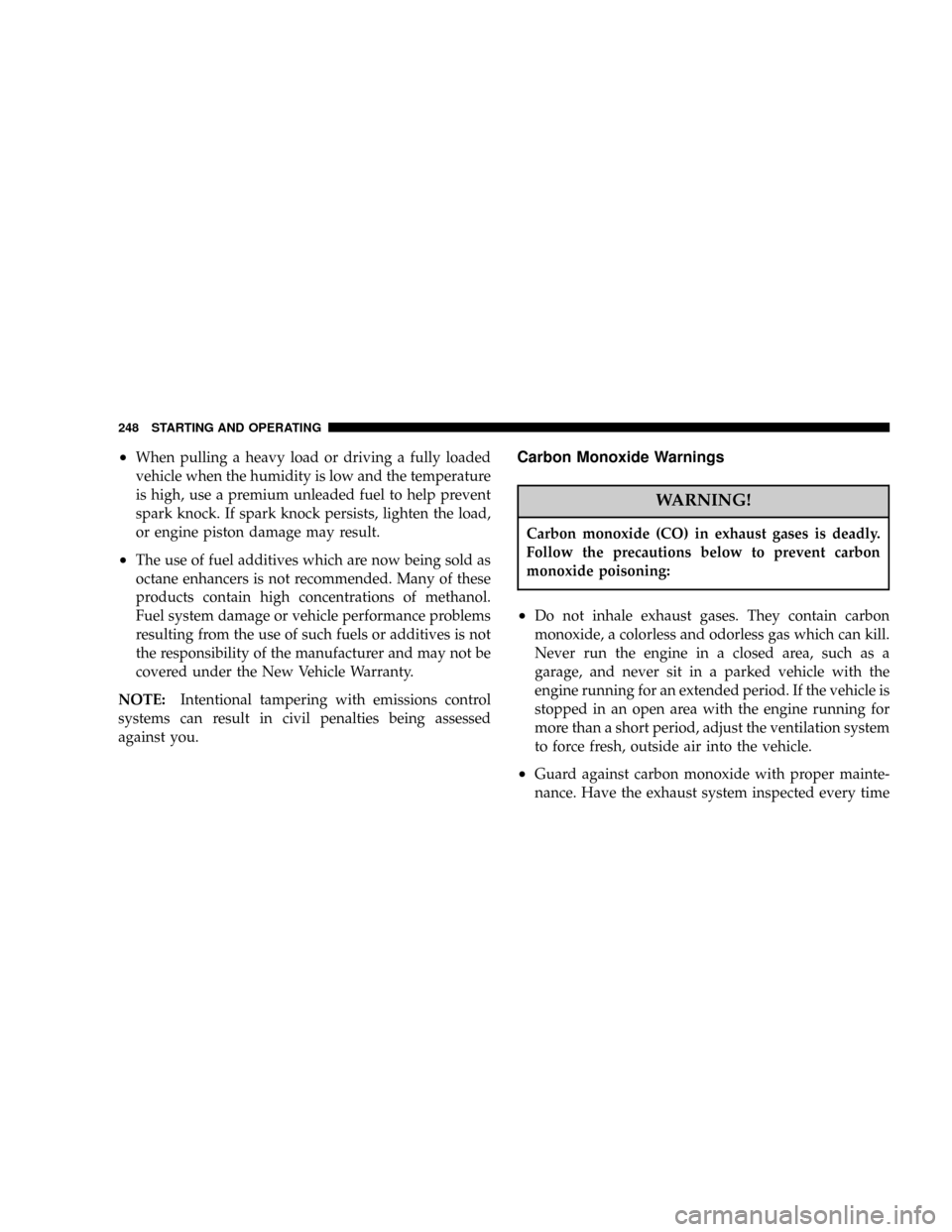
²When pulling a heavy load or driving a fully loaded
vehicle when the humidity is low and the temperature
is high, use a premium unleaded fuel to help prevent
spark knock. If spark knock persists, lighten the load,
or engine piston damage may result.
²The use of fuel additives which are now being sold as
octane enhancers is not recommended. Many of these
products contain high concentrations of methanol.
Fuel system damage or vehicle performance problems
resulting from the use of such fuels or additives is not
the responsibility of the manufacturer and may not be
covered under the New Vehicle Warranty.
NOTE:Intentional tampering with emissions control
systems can result in civil penalties being assessed
against you.
Carbon Monoxide Warnings
WARNING!
Carbon monoxide (CO) in exhaust gases is deadly.
Follow the precautions below to prevent carbon
monoxide poisoning:
²Do not inhale exhaust gases. They contain carbon
monoxide, a colorless and odorless gas which can kill.
Never run the engine in a closed area, such as a
garage, and never sit in a parked vehicle with the
engine running for an extended period. If the vehicle is
stopped in an open area with the engine running for
more than a short period, adjust the ventilation system
to force fresh, outside air into the vehicle.
²Guard against carbon monoxide with proper mainte-
nance. Have the exhaust system inspected every time
248 STARTING AND OPERATING
Page 259 of 386
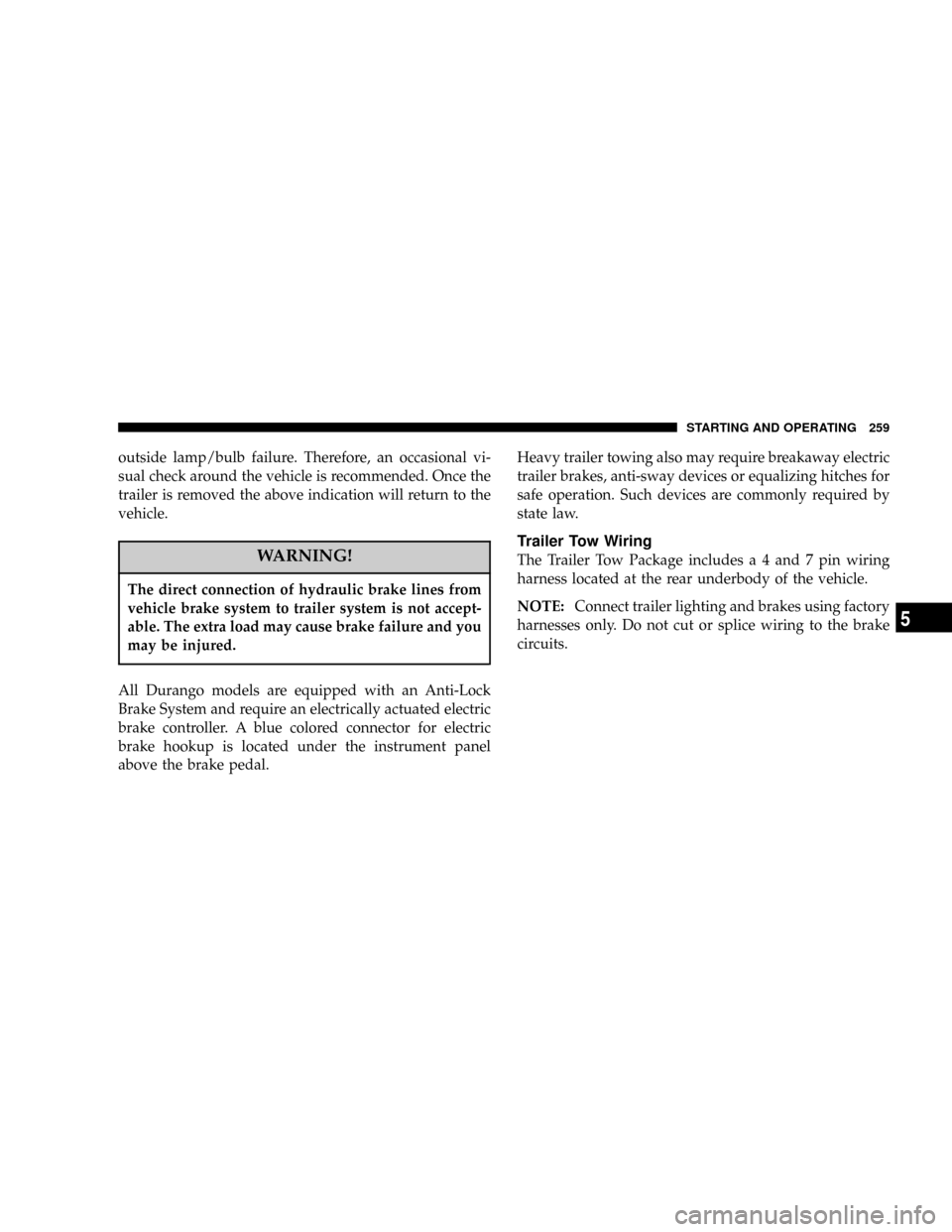
outside lamp/bulb failure. Therefore, an occasional vi-
sual check around the vehicle is recommended. Once the
trailer is removed the above indication will return to the
vehicle.
WARNING!
The direct connection of hydraulic brake lines from
vehicle brake system to trailer system is not accept-
able. The extra load may cause brake failure and you
may be injured.
All Durango models are equipped with an Anti-Lock
Brake System and require an electrically actuated electric
brake controller. A blue colored connector for electric
brake hookup is located under the instrument panel
above the brake pedal.Heavy trailer towing also may require breakaway electric
trailer brakes, anti-sway devices or equalizing hitches for
safe operation. Such devices are commonly required by
state law.
Trailer Tow Wiring
The Trailer Tow Package includes a 4 and 7 pin wiring
harness located at the rear underbody of the vehicle.
NOTE:Connect trailer lighting and brakes using factory
harnesses only. Do not cut or splice wiring to the brake
circuits.
STARTING AND OPERATING 259
5
Page 278 of 386
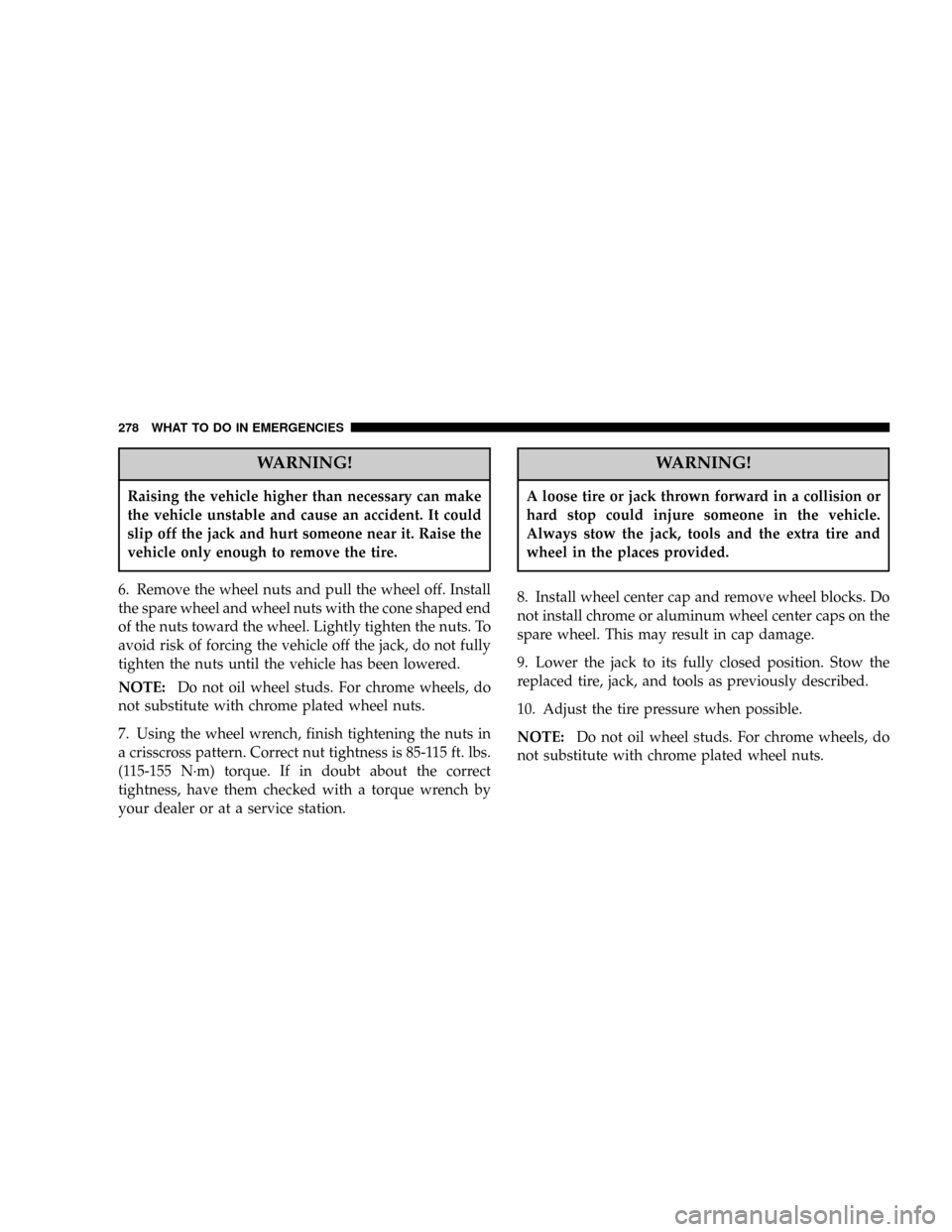
WARNING!
Raising the vehicle higher than necessary can make
the vehicle unstable and cause an accident. It could
slip off the jack and hurt someone near it. Raise the
vehicle only enough to remove the tire.
6. Remove the wheel nuts and pull the wheel off. Install
the spare wheel and wheel nuts with the cone shaped end
of the nuts toward the wheel. Lightly tighten the nuts. To
avoid risk of forcing the vehicle off the jack, do not fully
tighten the nuts until the vehicle has been lowered.
NOTE:Do not oil wheel studs. For chrome wheels, do
not substitute with chrome plated wheel nuts.
7. Using the wheel wrench, finish tightening the nuts in
a crisscross pattern. Correct nut tightness is 85-115 ft. lbs.
(115-155 N´m) torque. If in doubt about the correct
tightness, have them checked with a torque wrench by
your dealer or at a service station.
WARNING!
A loose tire or jack thrown forward in a collision or
hard stop could injure someone in the vehicle.
Always stow the jack, tools and the extra tire and
wheel in the places provided.
8. Install wheel center cap and remove wheel blocks. Do
not install chrome or aluminum wheel center caps on the
spare wheel. This may result in cap damage.
9. Lower the jack to its fully closed position. Stow the
replaced tire, jack, and tools as previously described.
10. Adjust the tire pressure when possible.
NOTE:Do not oil wheel studs. For chrome wheels, do
not substitute with chrome plated wheel nuts.
278 WHAT TO DO IN EMERGENCIES
Page 280 of 386
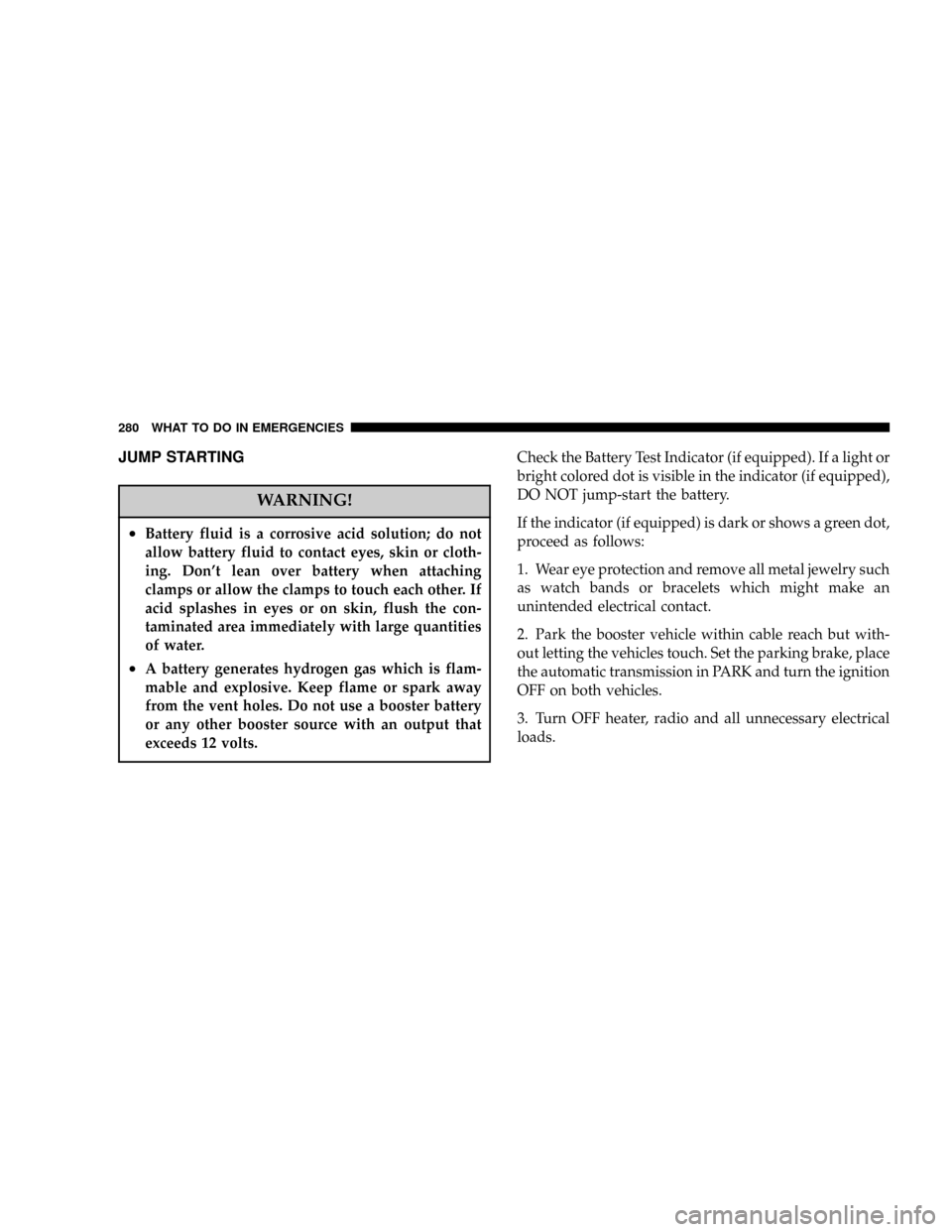
JUMP STARTING
WARNING!
²Battery fluid is a corrosive acid solution; do not
allow battery fluid to contact eyes, skin or cloth-
ing. Don't lean over battery when attaching
clamps or allow the clamps to touch each other. If
acid splashes in eyes or on skin, flush the con-
taminated area immediately with large quantities
of water.
²A battery generates hydrogen gas which is flam-
mable and explosive. Keep flame or spark away
from the vent holes. Do not use a booster battery
or any other booster source with an output that
exceeds 12 volts.
Check the Battery Test Indicator (if equipped). If a light or
bright colored dot is visible in the indicator (if equipped),
DO NOT jump-start the battery.
If the indicator (if equipped) is dark or shows a green dot,
proceed as follows:
1. Wear eye protection and remove all metal jewelry such
as watch bands or bracelets which might make an
unintended electrical contact.
2. Park the booster vehicle within cable reach but with-
out letting the vehicles touch. Set the parking brake, place
the automatic transmission in PARK and turn the ignition
OFF on both vehicles.
3. Turn OFF heater, radio and all unnecessary electrical
loads.
280 WHAT TO DO IN EMERGENCIES
Page 313 of 386

Brake System
Power Disc Brakes (Front)
Disc brakes do not require adjustment; however, several
hard stops during the break-in period are recommended
to seat the linings and wear off any foreign material.
Brake Master Cylinders
The fluid level in the master cylinders should be checked
whenever the vehicle is serviced, or immediately if the
brake system warning light is on. If necessary, add fluid
to bring level to the full mark on the side of the reservoir
of the brake master cylinder. Be sure to clean the top of
the master cylinder area before removing the cap. With
disc brakes, fluid level can be expected to fall as the brake
pads wear. Brake fluid level should be checked when
pads are replaced. If the brake fluid level is abnormally
low, check system for leaks.
Refer to Recommended Fluids, Lubricants and Genuine
Parts for correct fluid type.
MAINTAINING YOUR VEHICLE 313
7
Page 370 of 386

Adding Engine Coolant (Antifreeze).......... 309
Adding Fuel........................245,270
Air Cleaner, Engine...................... 298
Air Conditioner Maintenance............... 302
Air Conditioning........................ 184
Air Conditioning Controls................. 184
Air Conditioning Refrigerant.............302,303
Air Conditioning System................179,302
Air Filter.............................. 298
Air Pressure, Tires....................231,239
Airbag.............................38,153
Airbag Light............................ 50
Alarm..............................24,149
Alarm, Panic............................ 21
Alignment and Balance................... 238
Alterations/Modifications, Vehicle............. 6
Antenna, Satellite Radio................... 176
Antifreeze (Engine Coolant)..............308,335
Anti-Lock Brake System................... 218Anti-Lock Warning Light.................. 149
Anti-Theft System.....................24,149
Appearance Care........................ 321
Arming Theft System...................... 25
Auto Unlock............................ 16
Automatic Dimming Mirror...............70,74
Automatic Door Locks..................... 15
Automatic Headlights.................... 106
Automatic Temperature Control............. 184
Automatic Transaxle...................... 203
Automatic Transmission.............200,203,315
Adding Fluid......................316,317
Fluid and Filter Changes................. 318
Fluid Level Check...................315,316
Fluid Type........................318,338
Gear Ranges.......................... 203
Special Additives...................... 318
Torque Converter...................... 207
Axle Fluid............................. 338
370 INDEX
Page 371 of 386

Axle Lubrication........................ 319
Ball Joints............................. 304
Battery............................... 300
Charging............................ 280
Emergency Starting..................... 280
Gas Caution.......................... 280
Keyless Transmitter Replacement............ 24
Saving Feature........................ 105
Belts, Drive............................ 297
Belts, Seat.............................. 29
Body Mechanism Lubrication............... 304
B-Pillar Location........................ 226
Brake Fluid............................ 338
Brake System........................218,313
Anti-Lock........................... 218
Disc Brakes.......................... 313
Fluid Check.......................... 313
Hoses.............................. 314Master Cylinder....................... 313
Parking............................. 217
Warning Light.....................149,151
Brakes............................... 218
Brake/Transmission Interlock............... 203
Break-In Recommendations, New Vehicle........ 62
Bulb Replacement....................... 327
Bulbs, Light............................ 327
Calibration, Compass..................... 124
Capacities, Fluid........................ 335
Caps, Filler
Power Steering........................ 303
Car Washes............................ 321
Carbon Monoxide Warning................. 248
Cargo ................................ 250
Catalytic Converter....................249,299
CD Player..........................155,161
Cellular Phone........................74,179
INDEX 371
10